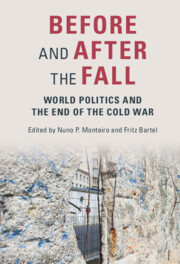Book contents
- Before and After the Fall
- Before and After the Fall
- Copyright page
- Dedication
- Epigraph
- Contents
- Figures
- Tables
- Contributors
- Preface
- Introduction
- Part I Sources of Continuity and Change
- Part II Continuity and Change Across the 1989/1991 Divide
- Part III Toward a New World Order?
- 12 Great Powers and the Spread of Autocracy Since the Cold War
- 13 Seeds of Failure
- 14 The United States and NATO After the End of the Cold War
- 15 The Historical Legacy of 1989
- 16 Requiem for a Cold War
- 17 After Primacy
- 18 World Order across the End of the Cold War
- Index
14 - The United States and NATO After the End of the Cold War
Explaining and Evaluating Enlargement and Its Alternatives
from Part III - Toward a New World Order?
Published online by Cambridge University Press: 02 December 2021
- Before and After the Fall
- Before and After the Fall
- Copyright page
- Dedication
- Epigraph
- Contents
- Figures
- Tables
- Contributors
- Preface
- Introduction
- Part I Sources of Continuity and Change
- Part II Continuity and Change Across the 1989/1991 Divide
- Part III Toward a New World Order?
- 12 Great Powers and the Spread of Autocracy Since the Cold War
- 13 Seeds of Failure
- 14 The United States and NATO After the End of the Cold War
- 15 The Historical Legacy of 1989
- 16 Requiem for a Cold War
- 17 After Primacy
- 18 World Order across the End of the Cold War
- Index
Summary
The United States emerged as the world’s sole superpower from the embers of the Cold War’s end, without, however, a wholesale reformulation of the principles and tools used to execute US grand strategy. This was particularly true in Europe, where the United States remained engaged politically, economically, and military; retained significant numbers of forward-deployed forces; and orchestrated the continuation and eventual expansion of NATO. For the United States, and for many Europeans, continued American dominance after 1991 of the continent’s security through NATO was a logical outgrowth of what Washington had provided in the West after 1945. Even within the context of America’s leadership of NATO, alternative strategies to the ultimate path of NATO’s post-1999 enlargement were possible. These included the Partnership for Peace, initially seen as an alternative to NATO enlargement formulated by the Pentagon; some enlargement of NATO to the east, but not as much as occurred; and a concrete path for Russia to join the alliance. This chapter considers the pros and cons of each of these alternatives to the NATO enlargement policy chosen by the United States and its partners in order to provide a more detailed assessment of the policy than has existed previously.
- Type
- Chapter
- Information
- Before and After the FallWorld Politics and the End of the Cold War, pp. 265 - 285Publisher: Cambridge University PressPrint publication year: 2021
- 1
- Cited by

